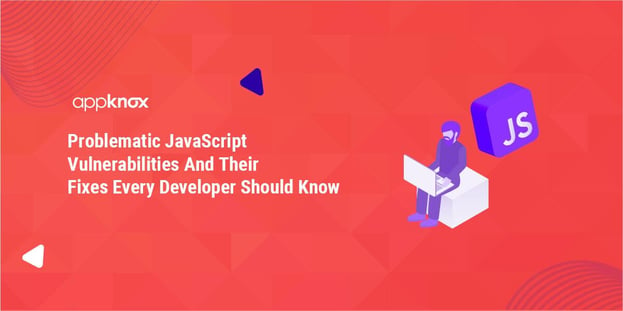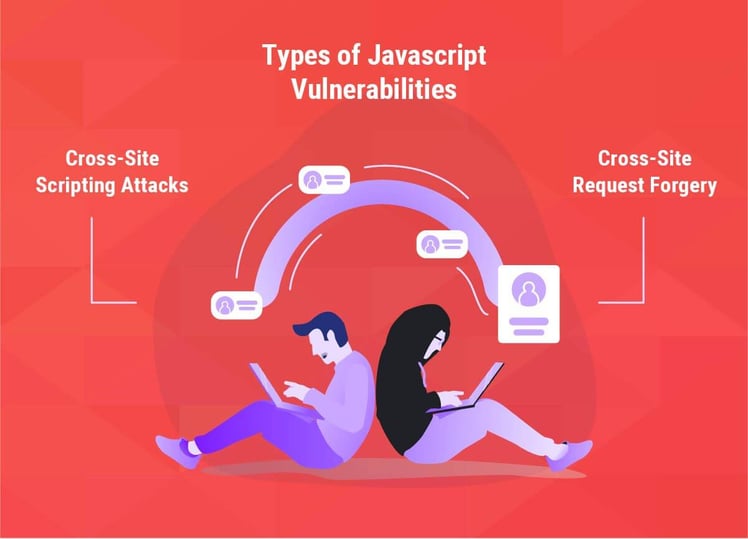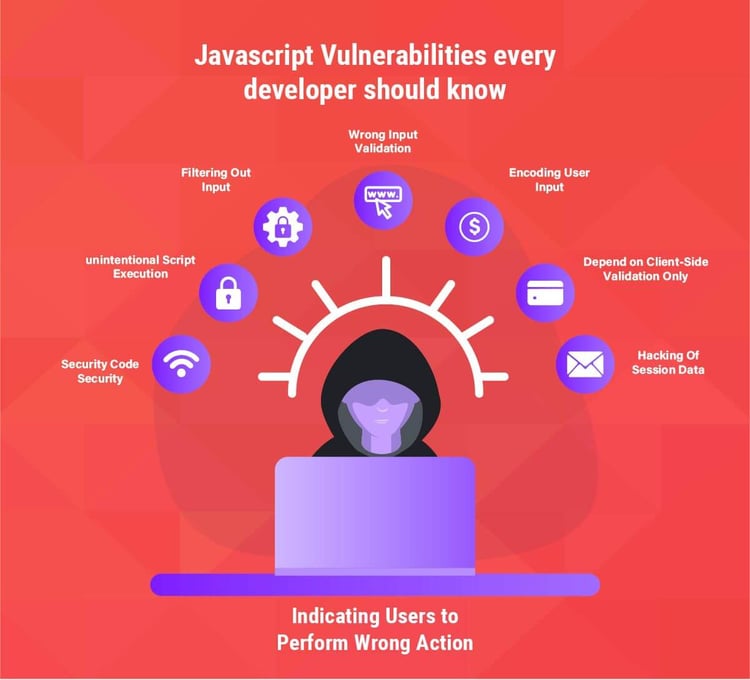
BLOG

BLOG
A web developer’s ultimate goal is to not only develop a website or an app that is aesthetically and functionally stunning but highly secure as well. Cybersecurity is inevitable and no end-user would want to have an app that could breach or compromise their data security and integrity (no matter how useful the app is). With hackers and middlemen working on creative ways to explore vulnerabilities, it is on developers like us to take charge and be a step ahead of them.
That’s why we should be aware of the vulnerabilities and security concerns during the coding stages. When we are familiar with the fundamental flaws associated with our code and programming languages, it would be simply easy for us to come up with workarounds, patches and even fixes. In today’s post, we are going to explore the vulnerabilities of JavaScript and see how we can overcome them.
Let’s get started.
No programming language is perfect, and JavaScript is no exception. As far as JavaScript web development is concerned, hackers can exploit many security aspects. The surprising part is that this compromise can happen both on the server and client sides. When a JavaScript vulnerability is exploited, hackers can easily manipulate and steal data, redirect user sessions, modify data, and do more.

This is the most common vulnerability, where hackers manipulate HTML and JavaScript scripts and launch malicious payloads with the help of a user’s browser. Because the script sits in the browser, it also gets embedded into web pages. The script is triggered whenever the user visits the page and performs an action. This attack can cause serious losses to companies, enterprises, and individuals, from identity theft to data breaches.
In this, malicious commands that often get rejected by websites trick them into believing that the user accessing the website is genuine and authorized. This forged authorization will allow hackers to access modules and aspects that remain denied to them otherwise. This causes consequences such as impersonation, identity theft, targeted attacks triggering, data modification through a victim’s credentials, exploitation of DSL routers, and more.

This vulnerability can be exploited in tandem with other vulnerabilities. Since JavaScript is an interpreted language, you cannot seal your source code from being visible to the public. However, with obfuscation, you can slow down the time hackers would require to reverse engineer their attempts.
The presence of libraries and packages is indeed a strength for Javascript developers. However, it is also a major shortcoming because of the number of unknown vulnerabilities it brings to your ecosystem. If you prefer packages to accomplish even a small task, you are only increasing the web security risks.
One ideal way to overcome source code concerns is deploying airtight auditing tools.
A major chunk of unintentional script execution attacks features Cross-site Scripting. JavaScript’s Document Object Model allows scripts to be embedded in web pages and launched on the client side. This event triggers untrusted and unauthorized scripts for launch. If you’ve visited forums online and been able to read other people’s messages, understand that it was a security concern falling under the topic of unintentional script execution.
In several cases, you can filter out dangerous characters from users’ input to protect them from data manipulation. While this solution is good, relying on this technique alone is not advisable to prevent data manipulation, as hackers can easily evade such input filters.
Input or data that users provide on websites should be properly validated. For instance, phone number boxes should accept only numbers with exceptions to a few special characters like + and -. Email addresses should mandatorily have the symbol @ and end with .com. Such validation techniques could patch certain vulnerabilities to significant extents.
Cross-site scripting attacks depend on supplying data that feature certain special characters for execution. These characters are used in underlying JavaScript, CSS, or HTML pages. Because of this, browsers that are supposed to display the values or characters misinterpret them to be part of the code or programming. This is what empowers hackers to breakout of text fields and provide additional browser-side codes for triggering.
This can be easily prevented by using escape codes for the special characters whenever browser-supplied data is returned as part of a response.
The techniques we discussed so far ideally work on the client side of browsers and web pages. However, hackers can often get creative and transmit data directly to servers, bypassing any and every client-side validation. This results in the uploading of malicious code or data onto the server. With no server-side validation protocol in place, the data that is stored could easily be corrupted, modified, or completely replaced.
The most practical fix to this is to implement client and server-side validations.
Malicious browser-side scripts are powerful, and they can access all sorts of content returned to the browser by web applications. Cookies are part of such content that can be accessed. As you know, cookies contain some of our most confidential and private data, and access to cookies means hackers can hijack our session IDs through the access of session ID tokens.
Sessions and local storage data can also be stolen in similar ways. That’s why it is recommended not to store confidential information such as tokens in the browser unless certain web development architecture dictates it.
Remember the cross-site request forgery exploitation we discussed a little earlier? At this point, you must understand that hackers gain access to unauthorized modules even when you are not online or in a session. This means that even if your website or application is not open, hackers could still be gaining access to authorized pages. This can happen to all cookie-based sessions through the request of authorization cookies.
Besides, hackers can publish their own web pages and force them to perform malicious activities or requests to other websites in the background (in stealth) when a user opens them. Through links posted on forums, social media platforms, and suspicious websites, browsers can be made to call or access other websites with the help of cookies.
To prevent this, you could deploy a tokenization mechanism where all client-server communications require an additional security token for data transmission. This token resides nowhere - not even in cookies. Every form should have a token generated and sent to the server for every request, as the user is still active on that particular website.
So, these were some of the lethal vulnerabilities and JavaScript security practices. Now that you know possible avenues where things can go wrong, ensure these loopholes are fixed or patched when you work on your next JavaScript project. If you’re working on one currently, revisit the aspects and implement whatever we discussed.
It’s always the minutest of the details that lead to colossal damages. Let’s build a safer internet for everyone out there. 

Hackers never rest. Neither should your security!
Stay ahead of emerging threats, vulnerabilities, and best practices in mobile app security—delivered straight to your inbox.
![]() Exclusive insights. Zero fluff. Absolute security.
Exclusive insights. Zero fluff. Absolute security.
![]() Join the Appknox Security Insider Newsletter!
Join the Appknox Security Insider Newsletter!
